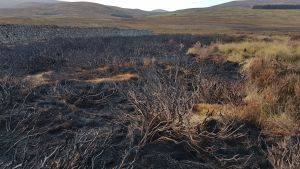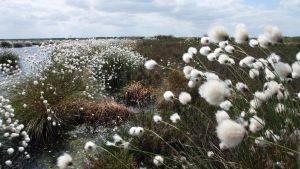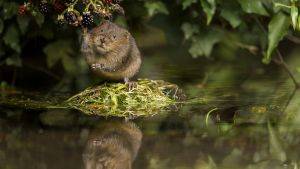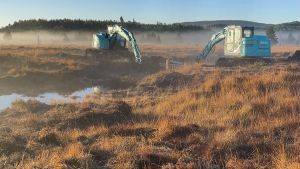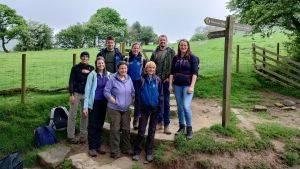Scottish Power Renewables has been test running a different method of grip blocking at their Black Law windfarm in Lanarkshire - one of the largest windfarms in the UK. In the past, they have found that building peat dams at the sufficient height, width and spacing to be effective creates too damaging an impact on the adjacent peatland, as well being both slow to work and expensive to build.
 To try address this, they have come up with a new method of blocking drains and are testing it over the winter months at Black Law. This new method uses a low ground pressure excavator, which straddles the drain (of circa 40-80 cm depth) and faces up the channel. Using a 90 cm wide bucket the machine carefully pulls 3-5 bucket widths of peat from the channel cross-section towards the machine itself. This creates an elevated ridge. Peter Robson, Senior Ecologist for Scottish Power Renewables says "it's a bit like wrinkling a carpet." Each blockage takes the machine operator less than two minutes to build.
To try address this, they have come up with a new method of blocking drains and are testing it over the winter months at Black Law. This new method uses a low ground pressure excavator, which straddles the drain (of circa 40-80 cm depth) and faces up the channel. Using a 90 cm wide bucket the machine carefully pulls 3-5 bucket widths of peat from the channel cross-section towards the machine itself. This creates an elevated ridge. Peter Robson, Senior Ecologist for Scottish Power Renewables says "it's a bit like wrinkling a carpet." Each blockage takes the machine operator less than two minutes to build.
Whilst a few potential issues have been identified, including limitations related to drain size (drains greater than one metre depth or width may not be appropriate), other concerns such as unknown performance during drought conditions and their long-term stability should be addressed via the monitoring Scottish Power Renewables will be conducting throughout the year.
So far however, the utilites and energy producer are pleased with the initial results, with the new method of grip blocking fast to create and inherently strong. The method also limits the exposure of bare beat and avoids the need for a borrow pit, whilst the blocks can also be made very wide to block an entire oxidised cross-section.
Lets hope the method proves to be robust.

